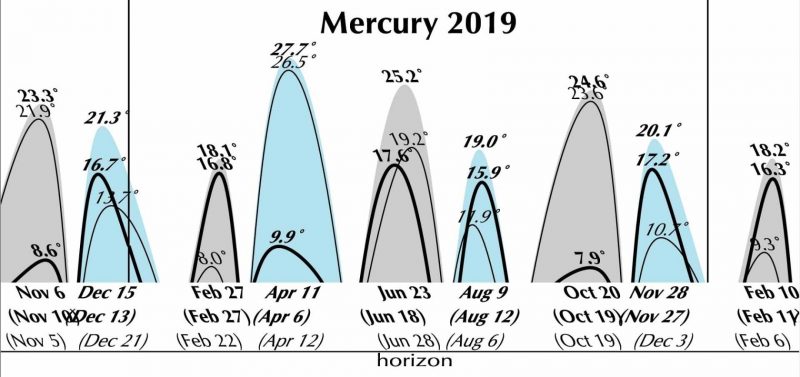

View larger. | At its farthest from the sun in our evening sky in late February and early March 2019, Mercury stands above the sunset point. Notice Mars, too! Chart via Guy Ottewell.
Mercury now stands farthest out from the sun, in the evening sky. Technically, we say that the planet is at its greatest eastward elongation. The extreme is reached on February 27, 2019 at 01:00 UTC. This is back in February 26 by American clocks – 8 p.m. for the Eastern time zone, 7 p.m. for the Central, and so on. The precise clock time is not so important. What’s important is that you look for the elusive little planet in the west shortly after sunset on these late February 2019 evenings, if the low sky is clear.
On the chart above, the arrows through Mercury and Mars show their movement (against the starry background) from 2 days before to 2 days after February 26.
The broad arrow on the celestial equator shows how far the sky appears to rotate in one hour. So Mercury will be down to the horizon in less than an hour after sunset, as seen from the latitude of this map (40 degrees N. latitude).
Now look at the chart below, which shows Mercury’s elongations from the sun – the best times to view the planet – for all of 2019.

View larger. | Here are the year’s apparitions of Mercury compared: 3 swings out from the neighborhood of the sun into the evening sky (gray) and 3 into the morning sky (blue). The top figures are the maximum elongations – maximum apparent distance from the sun – reached at the top dates given beneath. Curving lines show the altitude of the planet above the horizon at sunrise or sunset, for latitude 40 degrees North (thick line) and 35 degrees South (thin), with maxima reached at the parenthesized dates below (40 degrees North bold). Chart via Guy Ottewell.
You can see that for February 27 the elongation is not particularly great (18.1°). However, the thick curve almost fits up to the gray area. That is, the sunset altitude, for north-hemisphere observers, is almost as great as the elongation.
The reason for this favorabie geometry is clear in the sky scene at the top of this post. Mercury’s travel away from the sun appears vertical with respect to the horizon. It roughly follows the ecliptic, or sun’s path across our sky, which at this season – for temperate latitude in the Northern Hemisphere – is nearly vertical. And it also happens that Mercury, in this part of its orbit, is sloping slightly northward from the ecliptic.
It’s said that Copernicus, who made us understand that the planets revolve around the sun, was never able to see little Mercury from misty Poland. Perhaps you can research this for me and tell us whether it is just a Polish joke or an urban-pollution myth.
Bottom line: For the Northern Hemisphere, the best evening apparition of Mercury in 2019 comes in late February. Now is the time to look.
from EarthSky https://ift.tt/2ExjPua


View larger. | At its farthest from the sun in our evening sky in late February and early March 2019, Mercury stands above the sunset point. Notice Mars, too! Chart via Guy Ottewell.
Mercury now stands farthest out from the sun, in the evening sky. Technically, we say that the planet is at its greatest eastward elongation. The extreme is reached on February 27, 2019 at 01:00 UTC. This is back in February 26 by American clocks – 8 p.m. for the Eastern time zone, 7 p.m. for the Central, and so on. The precise clock time is not so important. What’s important is that you look for the elusive little planet in the west shortly after sunset on these late February 2019 evenings, if the low sky is clear.
On the chart above, the arrows through Mercury and Mars show their movement (against the starry background) from 2 days before to 2 days after February 26.
The broad arrow on the celestial equator shows how far the sky appears to rotate in one hour. So Mercury will be down to the horizon in less than an hour after sunset, as seen from the latitude of this map (40 degrees N. latitude).
Now look at the chart below, which shows Mercury’s elongations from the sun – the best times to view the planet – for all of 2019.

View larger. | Here are the year’s apparitions of Mercury compared: 3 swings out from the neighborhood of the sun into the evening sky (gray) and 3 into the morning sky (blue). The top figures are the maximum elongations – maximum apparent distance from the sun – reached at the top dates given beneath. Curving lines show the altitude of the planet above the horizon at sunrise or sunset, for latitude 40 degrees North (thick line) and 35 degrees South (thin), with maxima reached at the parenthesized dates below (40 degrees North bold). Chart via Guy Ottewell.
You can see that for February 27 the elongation is not particularly great (18.1°). However, the thick curve almost fits up to the gray area. That is, the sunset altitude, for north-hemisphere observers, is almost as great as the elongation.
The reason for this favorabie geometry is clear in the sky scene at the top of this post. Mercury’s travel away from the sun appears vertical with respect to the horizon. It roughly follows the ecliptic, or sun’s path across our sky, which at this season – for temperate latitude in the Northern Hemisphere – is nearly vertical. And it also happens that Mercury, in this part of its orbit, is sloping slightly northward from the ecliptic.
It’s said that Copernicus, who made us understand that the planets revolve around the sun, was never able to see little Mercury from misty Poland. Perhaps you can research this for me and tell us whether it is just a Polish joke or an urban-pollution myth.
Bottom line: For the Northern Hemisphere, the best evening apparition of Mercury in 2019 comes in late February. Now is the time to look.
from EarthSky https://ift.tt/2ExjPua

Aucun commentaire:
Enregistrer un commentaire